

Speech Therapy Store is dedicated to making your speech therapy life easier one resource at a time. To do this, we often partner with companies that share that mission. If you sign up or make a purchase through one of our partners’ links, we may receive compensation—at no extra cost to you.
If you’re looking for great IEP goals to work on phonological awareness or phonemic awareness IEP goals I’ve got you covered.
Plus I’ve gathered a list of free resources to take the work and stress out of your therapy planning this year.
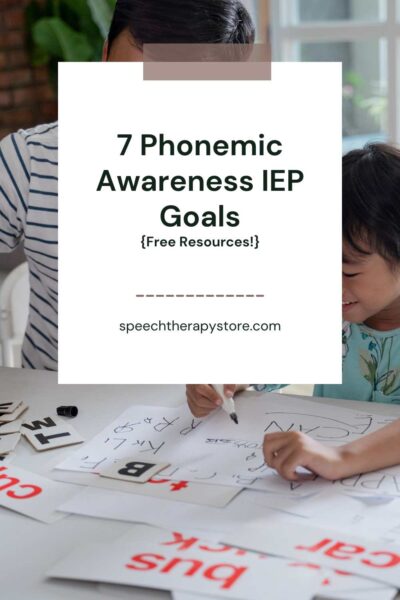
“Phonological awareness is the understanding of different ways that oral language can be divided into smaller components and manipulated.” (Chard and Dickson, 1999)
Phonological awareness focuses on manipulating the bigger parts of language, such as the ability to have students identify words that rhyme, breaking words apart into syllables, syllable blending, blending small words together, making compound words, or segmenting onset-rimes.
The last phonological awareness process to develop is called phonemic awareness.
Phonemic awareness is the ability to manipulate individual sounds and understand that a spoken word is made up of individual sounds or phonemes.
A phoneme is the smallest unit of sound within a word.
Phonemic awareness is part of phonological awareness as a sub-category.
Unlike phonological awareness looking at the bigger parts or chunks of language, we are asking students to hear individual sounds, a.k.a. phonemes, in a word.
For example, the following three separate sounds or phonemes /n/, /a/, /p/ when blended together make up the word “nap”.
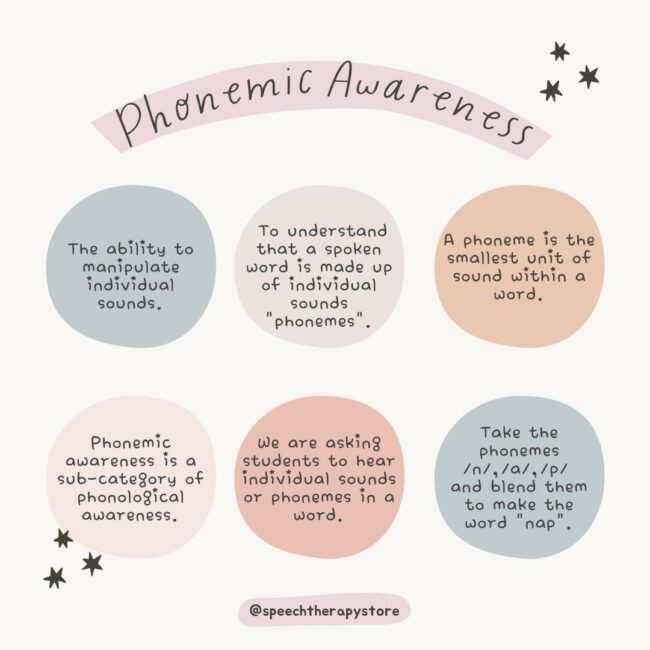
Phonemic awareness is crucial for our students’ reading success, especially during the early stages of reading development.
For typical readers, that means preschool, kindergarten, and first grade are very important times and an important school year for classroom teachers to focus on phonemic awareness.
In order for children to have success in their literacy development they must understand that words are made up of individual sounds (phonemes) and that these individual phonemes can be manipulated, blended, and segmented.
If students are able to do this through oral language, they can then transfer those skills over to print form. Helping with spelling and reading skills.
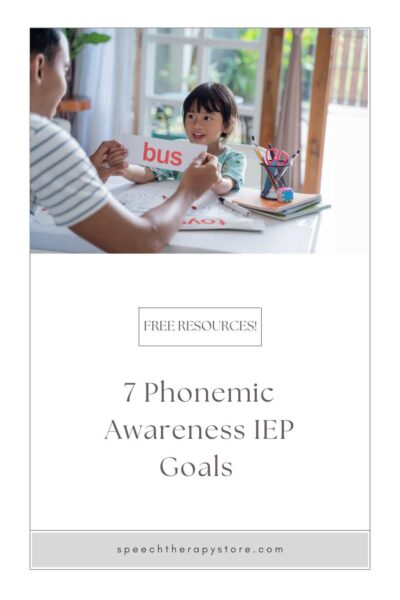
A great way to have more effective ways for formal instruction in phonemic awareness is to start with phonological awareness.
The first step is to start with the bigger units of language such as segmenting the word “seafood” into two syllables /sea/ and /food/ which is an easier task than asking your student to segment sounds into smaller units in a word such as /r/, /e/, /d/ for the word “red”.
Instruction should begin with phonological awareness (the largest unit of language, a word), and end with phonemic awareness (the smallest unit of language, a phoneme).
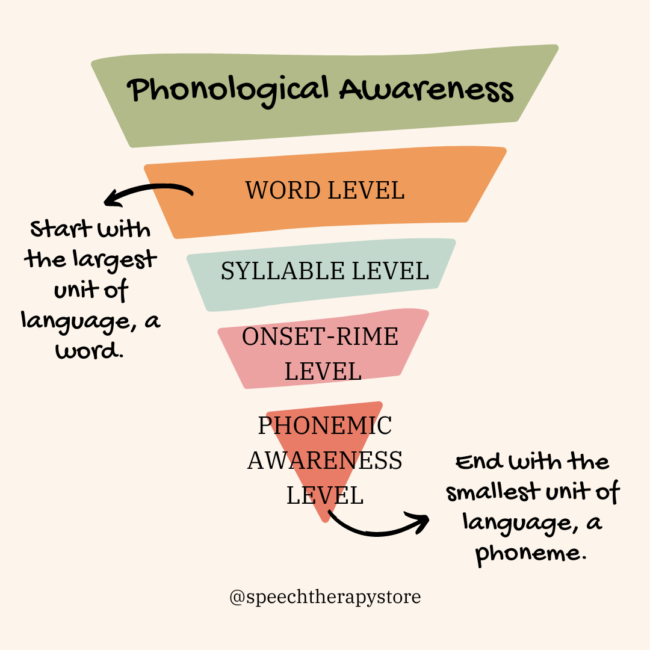
The word level works on blending, segmenting, and manipulating compound words.
| Word Level | |
| Blend | Blend the words “note” and “book” together – “notebook”. |
| Segment | Segment the word “bookstore” – “book” and “store”. |
| Add | Add the two words together “super” and “man” – “Superman”. |
| Delete | Delete the word “man” from the word “fireman” – “fire”. |
| Substitute | Substitute the word “day” to “place” from the word “birthday” – “birthplace”. |
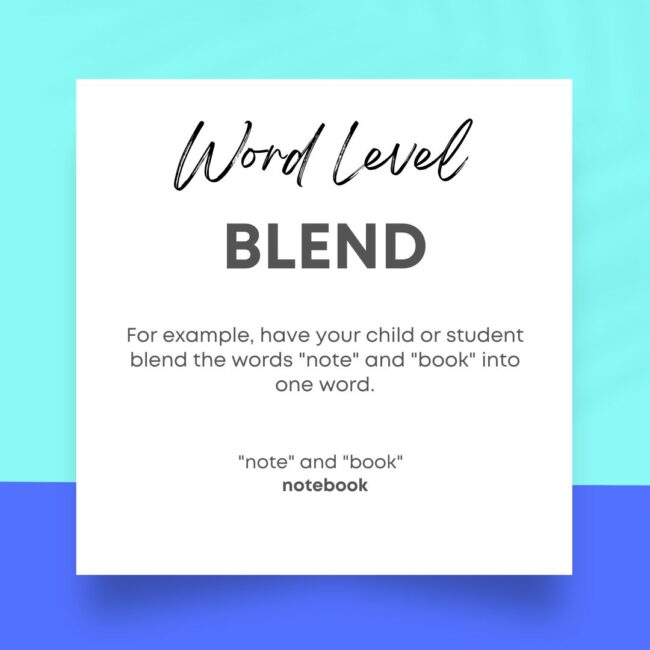
After the child can blend, segment, and manipulate compound words we move on to the next smallest unit which is syllables.
| Syllable Level | |
| Blend | Blend the three syllables sep-tem-ber – “September”. |
| Segment | Segment the word “basketball” into syllables – bas-ket-ball. |
| Add | Add the two syllables run-er – “runner”. |
| Delete | Delete the syllable -ing from the word baking – “bake”. |
| Substitute | Substitute the word “rain” for “waist” from the word “waistcoat” – “raincoat”. |
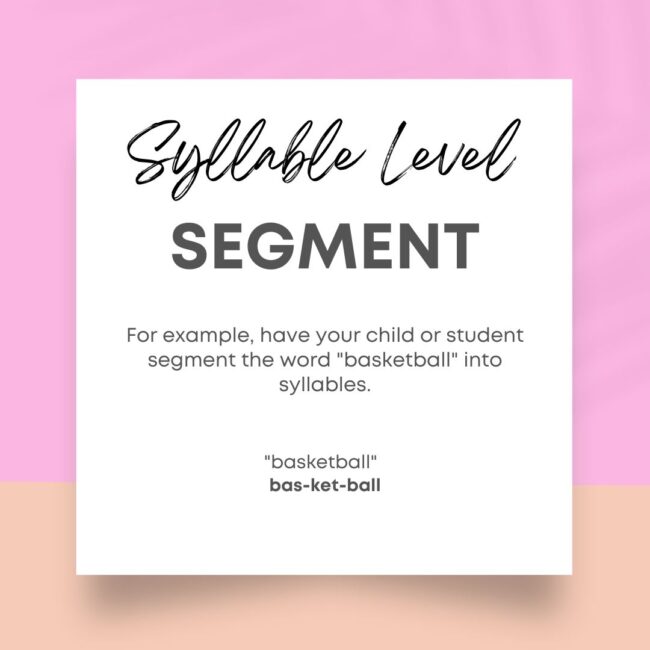
After the child can blend, segment, and manipulate syllables we move on to the next smallest unit which is onset and rime. Onset-rime is when you break a syllable apart into smaller parts. The onset is all the sounds that come before the vowel and the rime is the vowel and all the sounds that come after that.
| Onset-Rime Level | |
| Blend | Blend the onset /sl/ with the rime /ip/ – “slip”. |
| Segment | Segment the word “world” – onset /w/ & rime /orld/. |
| Add | Add the rime /ip/ and add the onset /t/ – “tip”. |
| Delete | Delete the onset /b/ from the word “band” – the rime is /and/. |
| Substitute | Substitute the onset /sl/ for /fl/ from the word “sled” – “fled”. |
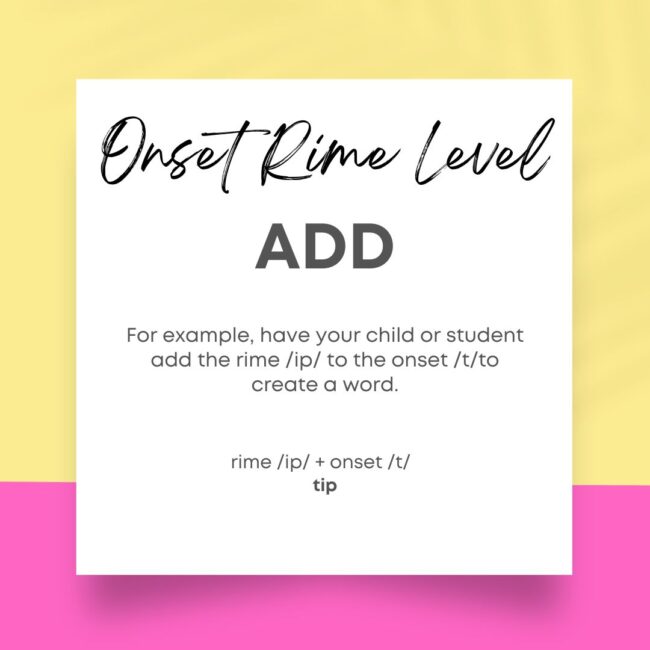
Working on a child’s understanding of phonological awareness will help to prepare them for hearing individual phoneme sounds and to begin working on phonemic awareness.
Lastly, after the child can blend, segment, and manipulate onset and rime we move on to the next smallest unit which is an individual phoneme or sound.
| Phoneme Level | |
| Isolation | Isolate the initial, medial, and final sounds in the word “nap” – /n/, /a/, /p/. |
| Blend | Blend the sounds /s/, /p/, /i/, /t/ together – “spit”. |
| Segment | Segment the word “swamp” into individual phonemes – /s/, /w/, /a/, /m/, /p/. |
| Add | Add the initial phoneme /t/ to /-ow/ – “tow”. |
| Delete | Delete the initial /s/ from the word “sand” – /-and/. |
| Substitute | Substitute the initial /f/ for /h/ from the word “five” – “hive”. |
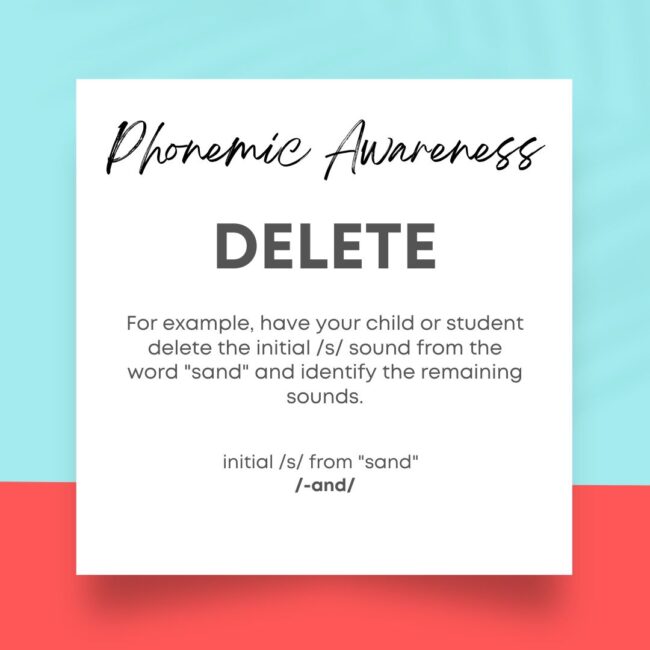
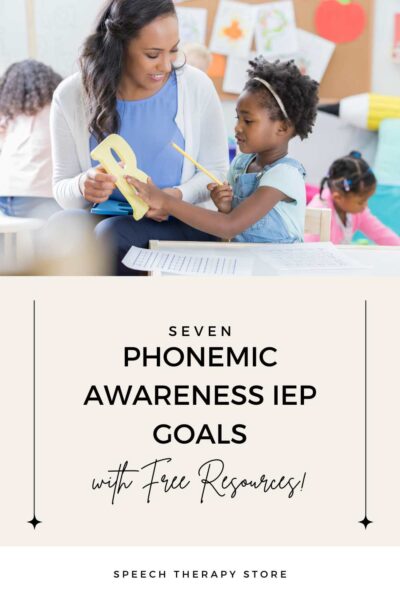
Calling all speech-language pathologists, special education teachers, or IEP team members if you’re on the hunt for a measurable annual goal for working on phonemic awareness or phonological awareness you’ll want to check out the following goals below.
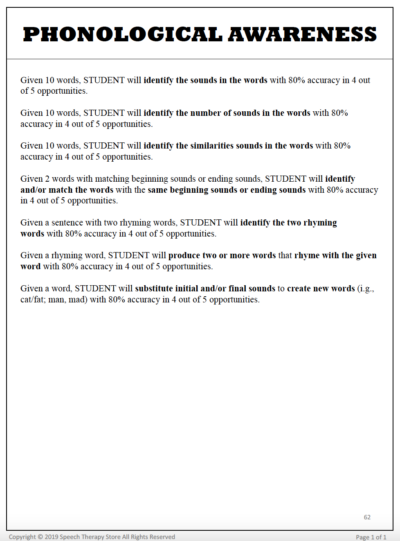
As a busy speech-language pathologist you’re always having to start a new IEP or at least that’s what it feels like. That’s why in addition to the phonemic awareness IEP goals, I’ve gone ahead and done the hard work for you and created an IEP goal bank filled with smart goals of over 432 sample IEP goals that you can copy and paste right onto your IEP paperwork.
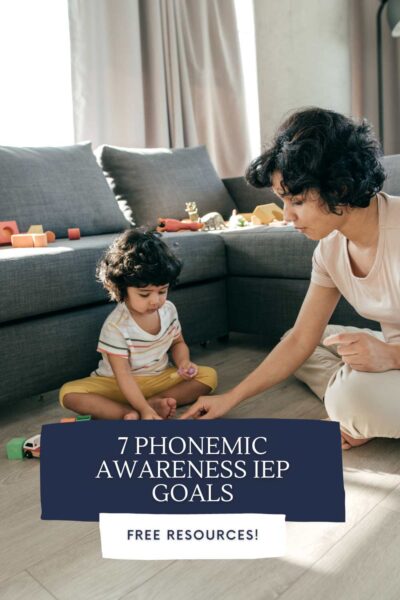
Below I’ve gathered some free phonological awareness tasks that you can use to make your therapy planning easier this year!
If you have a student working on blending at the word, syllable, onset-rime, or phoneme level here are a few resources worth checking out.
1. Back to School Blending and Segmenting Phonemic Awareness Worksheets cvc Words by Deborah Marines Teach Magically is a great resource to help practice phonemic awareness!
2. The Blending Coaster Phonemic Awareness Segmenting and Blending Activity by Natalie Lynn Kindergarten is a fun, engaging game for students to practice blending sounds together!
3. Beginning ‘S’ Blends Bump! game for Phonemic Awareness by Life over C’s and IteachToo is a really fun game to practice phonemic awareness. This game focuses on S Blends.
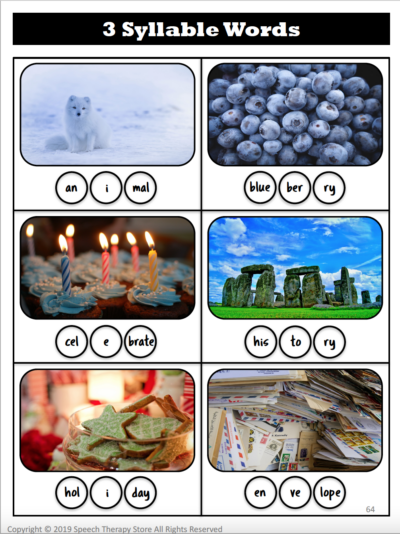
Here are a couple of activities that would be fun with a small group of students.
4. FREE Phonemic Awareness Warm Up Activity for small group reading by Elizabeth Ciavarella is a spinner game to practice and reinforce phonemic awareness. This is a simple and fun activity for students to do before guided reading.
5. Workin’ On Syllables by The Daily Alphabet is a set of 10 worksheets that can be used during small group work to practice early phonemic awareness!
6. Beginning Sound Strips: Phonemic Awareness Activity for K-1 by Andrea Knight is a set of 54 strips to help early readers practice sound discriminating between multiple sounds! This is an easy, no-prep activity.
If you have middle school or older students using resources with real-life photos can help make the resource appear more age-appropriate.
7. Multi-syllabic Words by Speech Therapy Store – Includes over 430 free real-life photo multi-syllabic words to work on your syllable blending and syllable segmenting skills.
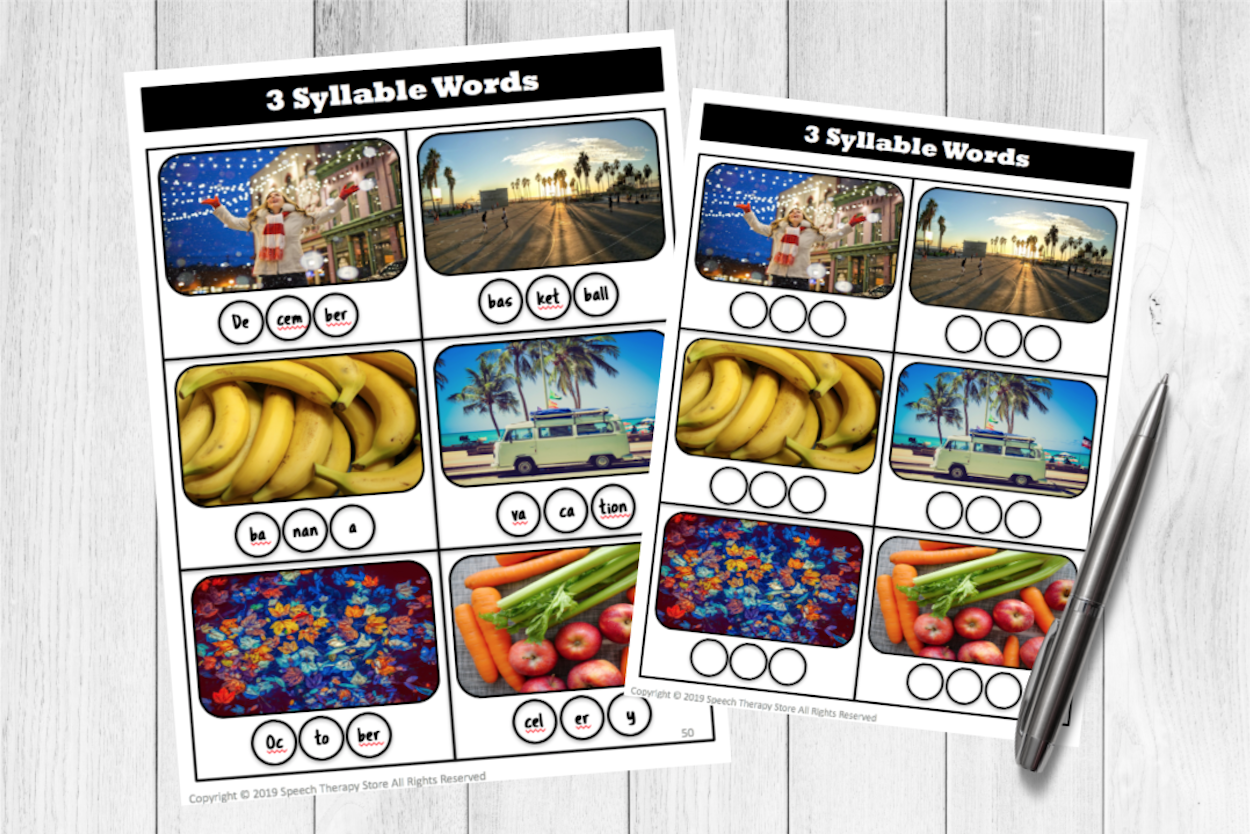
Here is an informal assessment to help you get started with phonemic awareness.
8. Phonemic Awareness Assessment FREEBIE by Sarah Paul is a great, free assessment that can be used to check your student’s phonemic awareness skills.
Come have some fun with your students while you work on phonemic awareness with the following resources.
9. Beginning and Ending Blends Picture Cards for Phonemic Awareness and Phonics by Phonolovable Literacy is a fun activity with the goal of practicing blending and segmenting short vowel words. This set is ready to print and go and has adorable graphics!
10. First Sound Fluency Freebie by Miss Kindergarten Love is a fun, engaging fluency game to practice phonemic awareness! Print out one of 2 game sheets, have students roll the dice, and say the first sound of each picture they move over. This is a great, engaging game for young learners.
11. Phonological Awareness No Prep Daily Drills FREE by Teach from A to Z is a set of 1,000 phonemic awareness tasks! The tasks are easy, fun, and ready to go for daily use!
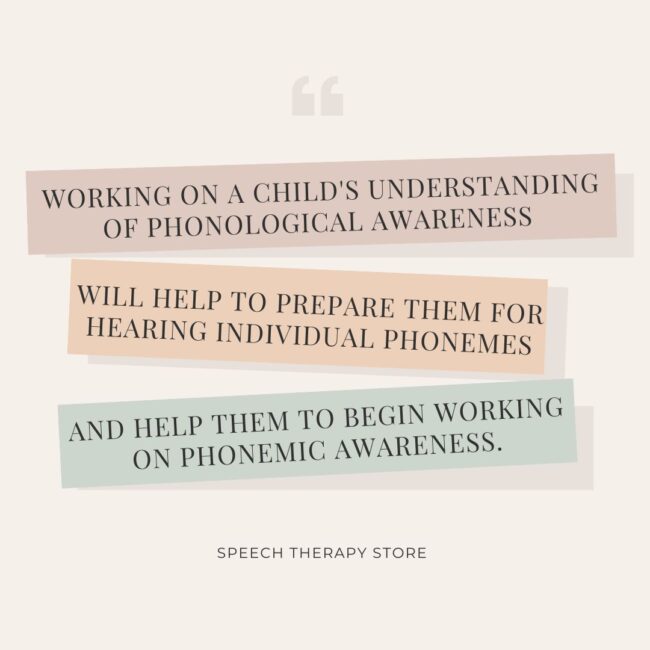
Use these task cards for an easy grab-and-go phonemic awareness lesson plan.
12. Phonemic Awareness Task Cards – Blending 3 Sounds FREEBIE by Helping Little Learners Grow is a set of 15 cards with 6 pictures each. Using picture support choices is a great way to help students practice blending! These are for younger students.
13. Missing Middle Short Vowel CVC Task Cards by Ryan McAdoo is a great resource to practice phonemic awareness! This creator has some fun ideas for how to use these task cards.
14. Phonemic Awareness by Rowdy in Room 300 is an engaging activity for students to practice phonemic awareness! Have students listen to the beginning sound and cross off the picture that does not sound the same. There is a card for each letter in the alphabet.
I hope the above phonemic awareness and phonological IEP goals help make your IEP writing a breeze this school year.
Plus use any of the ideas above to bring more fun into your phonological therapy.
Your students will surely thank you. Wishing you a wonderful year ahead.

Be sure to check out our most popular posts below!
